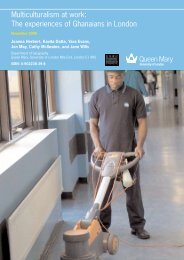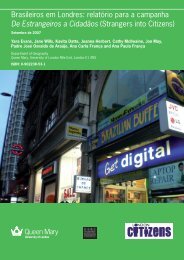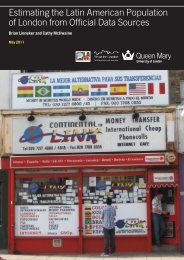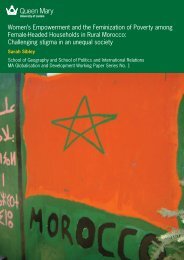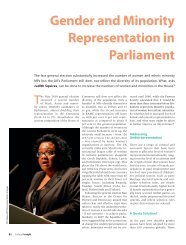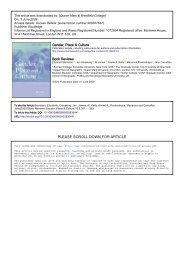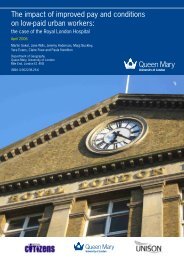The Colombian community in London - Geography - Queen Mary ...
The Colombian community in London - Geography - Queen Mary ...
The Colombian community in London - Geography - Queen Mary ...
- No tags were found...
You also want an ePaper? Increase the reach of your titles
YUMPU automatically turns print PDFs into web optimized ePapers that Google loves.
likely to be higher than this as some EU passport holders had false passports and some<br />
people hold<strong>in</strong>g student visas were semi-compliant <strong>in</strong> terms of work<strong>in</strong>g more hours than their<br />
visa allowed (see Table 1). Also important is that 36% had British passports, l<strong>in</strong>ked partly to<br />
the fact that <strong>Colombian</strong>s are the most established of all Lat<strong>in</strong> Americans liv<strong>in</strong>g <strong>in</strong> <strong>London</strong>.<br />
However, more specifically, 38% ga<strong>in</strong>ed citizenship through marriage, 19% through the family<br />
exercise, 9% through length of residence and another 9% directly through an asylum claim.<br />
Table 1: Immigration status at time of survey<br />
Type of immigration status Frequency Percent<br />
Student 20 20.0<br />
Work permit 4 4.0<br />
EU passport 12 12.0<br />
ILR/residency 12 12.0<br />
ELR 2 2.0<br />
British passport 36 36.0<br />
HSMP 1 1.0<br />
No documents 7 7.0<br />
Other 6 1.0<br />
Total 100 100.0<br />
Source: Questionnaire survey (N=100)<br />
LABOUR MARKET EXPERIENCES<br />
Employment rates among <strong>Colombian</strong> migrants are high with 81% <strong>in</strong> work. This is much higher<br />
than the overall rate for <strong>London</strong> residents born overseas and for the <strong>London</strong> population as a<br />
whole. Analysis of the Annual Population Survey also shows that the employment rate for<br />
adult Lat<strong>in</strong> Americans <strong>in</strong> <strong>London</strong> was 71% <strong>in</strong> 2008. In addition, Lat<strong>in</strong> Americans have higher<br />
employment rates than other foreign born workers <strong>in</strong> <strong>London</strong> (55%) and for the <strong>London</strong><br />
population as a whole (61%) (L<strong>in</strong>neker and McIlwa<strong>in</strong>e, 2011).<br />
<strong>Colombian</strong> migrants are concentrated <strong>in</strong> elementary positions <strong>in</strong> the labour market <strong>in</strong> <strong>London</strong><br />
(35%). <strong>The</strong>se <strong>in</strong>clude contract cleaners, kitchen assistants, porters, waiters and waitresses,<br />
hotel chambermaids and security guards. This is much higher than for the foreign born and the<br />
<strong>London</strong> population as a whole (17% of foreign born people, and 14% of all people liv<strong>in</strong>g <strong>in</strong><br />
<strong>London</strong>) (McIlwa<strong>in</strong>e et al, 2011: 54). When elementary jobs are added to personal service<br />
occupations, which here refer primarily to domestic clean<strong>in</strong>g and au pair<strong>in</strong>g, over half of<br />
<strong>Colombian</strong>s are employed <strong>in</strong> low-skilled, manual work, this means that 42% work <strong>in</strong><br />
elementary work. When this is calculated as a proportion of all workers, then 43% work <strong>in</strong><br />
elementary jobs, and when added to personal services, then 52% of work<strong>in</strong>g <strong>Colombian</strong>s work<br />
<strong>in</strong> the low-paid sector. Hav<strong>in</strong>g said this, 17.5% of all <strong>Colombian</strong>s work <strong>in</strong> professional,<br />
managerial and related occupations (or 21.5% of all workers) (see Figure 9). Aga<strong>in</strong>, this is<br />
lower than the <strong>London</strong> population as a whole where 29% of those born abroad and 34% of the<br />
<strong>London</strong> population as a whole work <strong>in</strong> these sectors (McIlwa<strong>in</strong>e et al, 2011: 56).<br />
Work<strong>in</strong>g <strong>Colombian</strong> men were more likely to be work<strong>in</strong>g <strong>in</strong> professional and managerial jobs<br />
compared with women (22% compared with 14%) with a slight concentration of women <strong>in</strong><br />
elementary jobs (36% compared with 34% of men). L<strong>in</strong>ked ma<strong>in</strong>ly with nanny and au pair<br />
work, women were also much more likely to be employed <strong>in</strong> personal service jobs (11%<br />
compared with 3% of men). 5 <strong>The</strong> year of arrival also affects the economic activities of<br />
5 An analysis of the APS for Lat<strong>in</strong> Americans as a whole shows a broadly similar trend although the<br />
overall concentration <strong>in</strong> elementary jobs is more marked. For example, 30% of men were<br />
concentrated <strong>in</strong> rout<strong>in</strong>e and semi-rout<strong>in</strong>e occupations and another 26% <strong>in</strong> managerial and<br />
15



